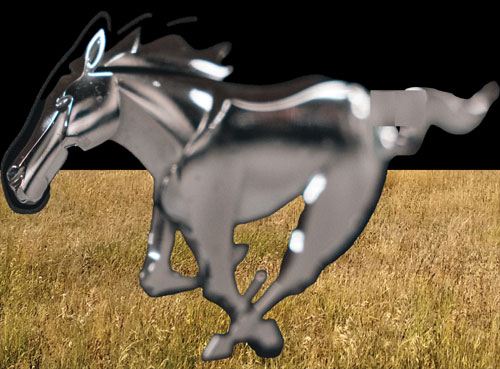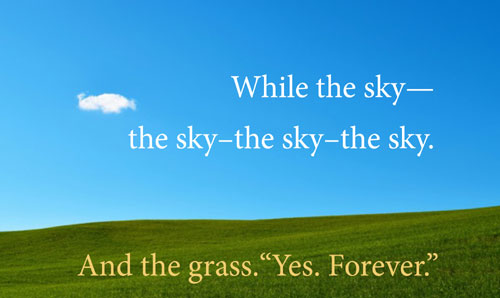|
“The Little Girl by the Fence at School”
—William Stafford—

Grass that was moving found all shades of brown,
Moved them along, flowed autumn away,
Galloping southward where summer had gone.
And that was the morning someone’s heart stopped,
And all became still. A girl said, “Forever?”
And the grass. “Yes. Forever.” While the sky—
The sky — the sky — the sky.
I am a fan of the very short poem which I define here as eight lines or less. I
write them often, and when I teach writing to beginning poets, I encourage
them to master the art of the short poem before tackling longer ones.
The great virtue of the very short poem is memorability. One must read
multi-page poems like Robert Frost’s “Mending Wall” or Ezra Pound’s
“Hugh Selwyn Mauberley” or William Carlos William’s “Asphodel that
Greeny Flower” many times and work for hours to commit each to memory.
But read the following short poems by Frost, Pound, and Williams just once
and they will most likely become unforgettable:
The Secret Sits
We dance around in a ring and suppose,
But the Secret sits in the middle and knows.
In a Station of the Metro
The apparition of these faces in the crowd
Petals on a wet, black bough.
The Red Wheelbarrow
So much depends
upon
a red wheel
barrow
glazed with rain
water
beside the white
chickens.
Robert Frost said his goal was to “to lodge a few poems where they will be
hard to get rid of.” If these intriguing short poems are favorites with many
and widely discussed by ordinary readers and professional critics alike it is
largely because they have lodged themselves firmly in a multitude of
imaginations.
William Stafford’s “The Little Girl by the Fence at School” demonstrates how
emotionally and philosophically rich and powerful just eight lines of poetry
can be. The narrative in this poem is implicit, so I’ll begin by attempting to
bring it forward via the Who, What, When, Where, Why and How of
storytelling.
Stafford’s title does not merely serve as a label. It acts as the poem’s essential
first line as well. Since it establishes its Who as a “little girl” and its Where as
“by the Fence at School” the rest of the poem would not make sense without
it.
Why the girl is at the fence and What occurs there, however, is not made
clear until the middle of the second stanza. The first stanza is devoted to
vividly establishing the poem’s When:
Grass that was moving found all shades of brown,
Moved them along, flowed autumn away,
Galloping southward where summer had gone.
It is a windy day in late autumn. The grass is covered with dead leaves. The
wind blowing through the grass is carrying the leaves away. The language
here is not at all like the prosaic title. Its purpose is to make us feel the
emotional effect that the weather and environment convey. Stafford
accomplishes this by personifying the grass and animalizing the autumn
season.

The windblown grass is personified as a cowboy driving the dead leaves
along the ground, as if they were horses “galloping southward” towards
“where summer had gone.” Walking through the blowing grass and whirling
dead leaves to reach the schoolyard fence the little girl would have
experienced the relentless but beautiful flow and vigor of autumn.
Now we come to WHY the girl is at the fence. Stanza one was all about
motion. The first line and a half of stanza two is about cessation and like the
title line is quite prosaic:
Someone related to the girl has died and someone has come to the school to
tell her and perhaps bring her home to her family.
We might also ask HOW the girl came to the fence. Possibly her teacher told
her that her mother or father or other relative was waiting for her there; or
maybe she was playing in the schoolyard at recess and ran to join a relative
who was calling to get her attention.
Notice that, again and again, Stafford has declined to give us such details.
The word “leaves,” for example, is never stated but is implied in the grass
finding and moving away “all shades of brown” (leaves acting as symbols of
the fall season).
All we know about the girl is that she is “little” which suggests that she will
be confronting the concept of death for the first time. All we know about the
deceased is that “someone’s heart stopped” and that he or she was somehow
related to the girl. We don’t need to know if it was her mother, father, aunt,
uncle, grandparent, brother, or sister. Everything here is moving towards
this poem’s essential WHAT— its focus on the child’s attempt to come to
grips with the fact that people die, disappear, cross to the other side of an
unbridgeable fence; possibly arrive, in Hamlet’s words, at “The undiscovered
country from whose bourn / No traveler returns.”
Looking down at the grass, the child wonders if death means that she will no
longer see her loved one again. She poses that question, not to the grass or
the person who has come to fetch her, but to herself as she asks:
“Forever?”
The feeling she gets from the grass offers no comfort:
“Yes. Forever.”
But the line doesn’t end there. It continues with an implicit answer,
reiterated three times by Stafford’s concluding one-line stanza:

As the girl looks up, the sky provides her and readers with a very different feeling from the finality of being buried under grass, of being gone “forever.”
The sky’s never-ending expansiveness suggests a different sort of “forever,”
where the metaphorical horses ever gallop towards “summer”; where
nature’s cycle is never one of cessation, but of eternal movement towards
replenishment.
It’s all but impossible to imagine that changing a word or syllable of
Stafford’s poem (or adding or deleting anything) would improve it. Writing
short poems is an excellent way to attain what Gerald Manly Hopkins called
“The Habit of Perfection,” a habit that will serve poets well when writing
longer works.
|